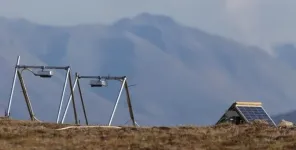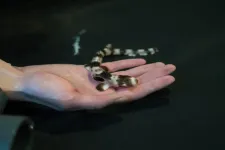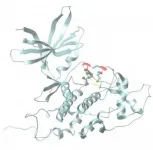New taxonomy of non-skeletal rare disorders with impact on bone
Outlines six groups of rare disorders that may influence the activity of bone cells or the characteristics of bone matrix, classified according to the systemic disease, genetic defect, pathophysiology of bone phenotype, and therapy.
2021-01-12
(Press-News.org) Thanks to major progress in the understanding and management of rare congenital diseases and syndromes, many patients with these rare disorders are now living longer lives. With this progress it has become apparent that many non-skeletal rare diseases have an impact on bone mass, bone quality and/or bone metabolism, with potentially severe repercussions for quality of life in adults.
The new paper 'Bone fragility in patients affected by congenital diseases non skeletal in origin', published in Orphanet Journal of Rare Diseases by the International Osteoporosis Foundation (IOF) Skeletal Rare Diseases Working Group (SRDWG), provides a first taxonomic classification of selected non-skeletal rare congenital disorders with an impact on bone physiology on the basis of phenotypes. The diseases have been described according to the systemic disease; genetic defect; pathophysiology of bone phenotype; and therapy, where available.
The classifications are provided in separate tables for these rare disorders as follows:
Metabolic rare diseases: lysosomal storage diseases, disorders of sulphur metabolism, disorders of tyrosine pathway
Liver rare diseases: disorders of copper pathway (Menkes and Wilson disease)
Respiratory rare disease: cystic fibrosis
Hematological rare diseases: mastocytosis, beta-thalassemia, hemophilia, sickle cell disease, Ghosal hemato-diaphyseal dysplasia, severe congenital neutropenia, Histiocytosis
Neurological Rare Disease: Rett Syndrome
Malformation: Tricho-rhino-phalangeal syndrome, type I
Professor Maria-Luisa Brandi, chair of the past IOF SRD Working Group and convener of the IOF Skeletal Rare Disease Academy, stated:
"With this work, we have established the first classification of systemic rare diseases which alter bone metabolism and which may be amenable to different therapeutic approaches to maintain bone health. We look forward to updating the classification as new knowledge and new therapeutic options become available."
Professor Nicholas Harvey, chair of the IOF Committee of Scientific Advisors (CSA) and the IOF Skeletal Rare Disease Academy, added:
"This new publication, documenting a novel approach to the classification of these rare diseases, demonstrates the enormous value in bringing together global leaders in this field through the International Osteoporosis Foundation's science programme, continuing through the IOF Skeletal Rare Diseases Academy, to generate state-of-the-art reports that will inform clinical practice worldwide."
INFORMATION:
Further reading:
Masi, L., Ferrari, S., Javaid, M.K. et al. Bone fragility in patients affected by congenital diseases non skeletal in origin. Orphanet J Rare Dis 16, 11 (2021).
https://doi.org/10.1186/s13023-020-01611-5
Masi L, Agnusdei D, Bilezikian J, Chappard D, Chapurlat R, Cianferotti L, et al. Taxonomy of rare genetic metabolic bone disorders. Osteoporos Int 2015; 26:2529-2558
https://link.springer.com/article/10.1007/s00198-015-3188-9
International Osteoporosis Foundation Atlas of Rare Genetic Metabolic Bone Disorders
https://www.osteoporosis.foundation/health-professionals/skeletal-rare-disorders
About IOF:
The International Osteoporosis Foundation (IOF) is the world's largest nongovernmental organization dedicated to the prevention, diagnosis and treatment of osteoporosis and related musculoskeletal diseases. IOF members, including committees of scientific researchers as well as 266 patient, medical and research societies, work together to make fracture prevention and healthy mobility a worldwide health care priority. https://www.osteoporosis.foundation @iofbonehealth
About the IOF Skeletal Rare Diseases Academy:
To continue the important work of the former IOF Skeletal Rare Disease Working Group, IOF launched the Skeletal Rare Diseases Academy in 2020. The Academy is comprised of leading experts in the field whose mission is to advance and disseminate much needed knowledge in the field, and communicate the importance of diagnosis, management and support for rare diseases. Areas of activity will include publications in scientific journals, developing educational programmes and training courses, and providing practical informational resources for patients and healthcare professionals. In addition, the Academy will present awards to recognize and promote research excellence and the work of young scientists in the field. https://bit.ly/35h3zKC
ELSE PRESS RELEASES FROM THIS DATE:
2021-01-12
Most people experience turbulence primarily from the experience of flying in an airplane. However, turbulence is a key feature of nature and is found everywhere, from rivers to galaxies.
Turbulent-like dynamics are difficult to capture in a still image. However, Leonardo da Vinci did everything possible to identify the underlying order of the phenomenon, which he observed in eddy currents forming randomly in water. In fact, he was fascinated by trying to understand and describe the generating principles governing such complicated dynamics. This is so much ...
2021-01-12
Scientists are combining artificial intelligence and advanced computer technology with biological know how to identify insects with supernatural speed. This opens up new possibilities for describing unknown species and for tracking the life of insects across space and time
Insects are the most diverse group of animals on Earth and only a small fraction of these have been found and formally described. In fact, there are so many species that discovering all of them in the near future is unlikely.
This enormous diversity among insects also means that they have very different life histories and roles in the ecosystems.
For ...
2021-01-12
A new study conducted at the New England Aquarium finds that as climate change causes the ocean to warm, baby sharks are born smaller, exhausted, undernourished, and into environments that are already difficult for them to survive in.
In a recently published paper in the journal Scientific Reports, lead author Carolyn Wheeler, a Ph.D. candidate at the University of Massachusetts Boston and at the ARC Centre of Excellence for Coral Reef Studies at James Cook University, examined the effects of increased temperatures on the growth, development and physiological performance of epaulette ...
2021-01-12
It's been more than a year since the first cases were identified in China, yet the exact origins of the COVID-19 pandemic remain a mystery. Though strong evidence suggests that the responsible coronavirus originated in bats, how and when it crossed from wildlife into humans is unknown.
In a study published online Jan.12 in the journal mBio, an international team of 15 biologists say this lack of clarity has exposed a glaring weakness in the current approach to pandemic surveillance and response worldwide.
In most recent studies of animal-borne pathogens with the potential to spread to humans, known as zoonotic pathogens, physical specimens of suspected wildlife ...
2021-01-12
Exercising regularly is one of the best defences against metabolic diseases, such as obesity and diabetes - but why? It's a question that scientists are still struggling to answer. While exercising changes the molecular behaviour of muscles, it's not well understood how these molecular changes improve metabolic health.
Scientists at the University of Copenhagen have now developed a new technology that allows researchers to study muscle biology on a more detailed level - and hopefully find some new answers. They extracted 'fast' and 'slow' twitch muscle fibers from freeze-dried muscle samples that were taken before and after 12 weeks of cycling exercise training. Their comprehensive analysis of the protein expression of the fibers provides new evidence that the ...
2021-01-12
BOSTON -- By mid-November, the Centers for Disease Control and Prevention had reported that 218,439 health care workers in the U.S. had been infected with COVID-19 -- a likely underestimate due to incomplete data from states. About 3% to 4% of health care personnel who recover from coronavirus infection are expected to become "COVID long-haulers" as they cope with debilitating symptoms 12 to 18 months after the acute stage of the infection clears.
"As COVID-19 surges again, hospitals are facing a shortage of skilled frontline providers who can meet the relentless demands of caring for these patients," says Zeina N. Chemali, MD, MPH, a psychiatrist and neurologist at Massachusetts ...
2021-01-12
A group of scientists from Russia, China, and the United States predicted and then experimentally obtained barium superhydrides' new unusual superconductors. The study was published in Nature Communications.
Chemists and physicists have been hunting down room-temperature superconductors since the first half of the 20th century. Initially, high hopes were placed on metallic hydrogen, but solid metallic hydrogen can become superconducting only at extremely high pressures of several million atmospheres, as it later transpired. Chemists then tried adding other elements to hydrogen in the hope of attaining superconductivity by stabilizing the metallic state under less challenging conditions. ...
2021-01-12
Typically characterized as poisonous, corrosive and smelling of rotten eggs, hydrogen sulfide's reputation may soon get a face-lift thanks to Johns Hopkins Medicine researchers. In experiments in mice, researchers have shown the foul-smelling gas may help protect aging brain cells against Alzheimer's disease. The discovery of the biochemical reactions that make this possible opens doors to the development of new drugs to combat neurodegenerative disease.
The findings from the study are reported in the Jan. 11 issue of the Proceedings of the National Academies of Sciences.
"Our new data firmly link aging, neurodegeneration and cell signaling using hydrogen sulfide and other gaseous molecules within the cell," says Bindu Paul, M.Sc., Ph.D., faculty ...
2021-01-12
Climate changes prompt many important questions. Not least how it affects animals and plants: Do they adapts, gradually migrate to different areas or become extinct? And what is the role played by human activities? This applies not least to Greenland and the rest of the Artic, which are expected to see the greatest effects of climate changes.
'We know surprisingly little about marine species and ecosystems in the Arctic, as it is often costly and difficult to do fieldwork and monitor the biodiversity in this area', says Associate Professor of marine mammals and instigator of the study ...
2021-01-12
Researchers from Skoltech and their colleagues have optimized data analysis for a common method of studying the 3D structure of DNA in single cells of a Drosophila fly. The new approach allows the scientists to peek with greater confidence into individual cells to study the unique ways DNA is packaged there and get closer to understanding this crucial process's underlying mechanisms. The paper was published in the journal Nature Communications.
The reason a roughly two-meter-long strand of DNA fits into the tiny nucleus of a human cell is that chromatin, a complex of DNA and proteins, packages it ...
LAST 30 PRESS RELEASES:
[Press-News.org] New taxonomy of non-skeletal rare disorders with impact on bone
Outlines six groups of rare disorders that may influence the activity of bone cells or the characteristics of bone matrix, classified according to the systemic disease, genetic defect, pathophysiology of bone phenotype, and therapy.




